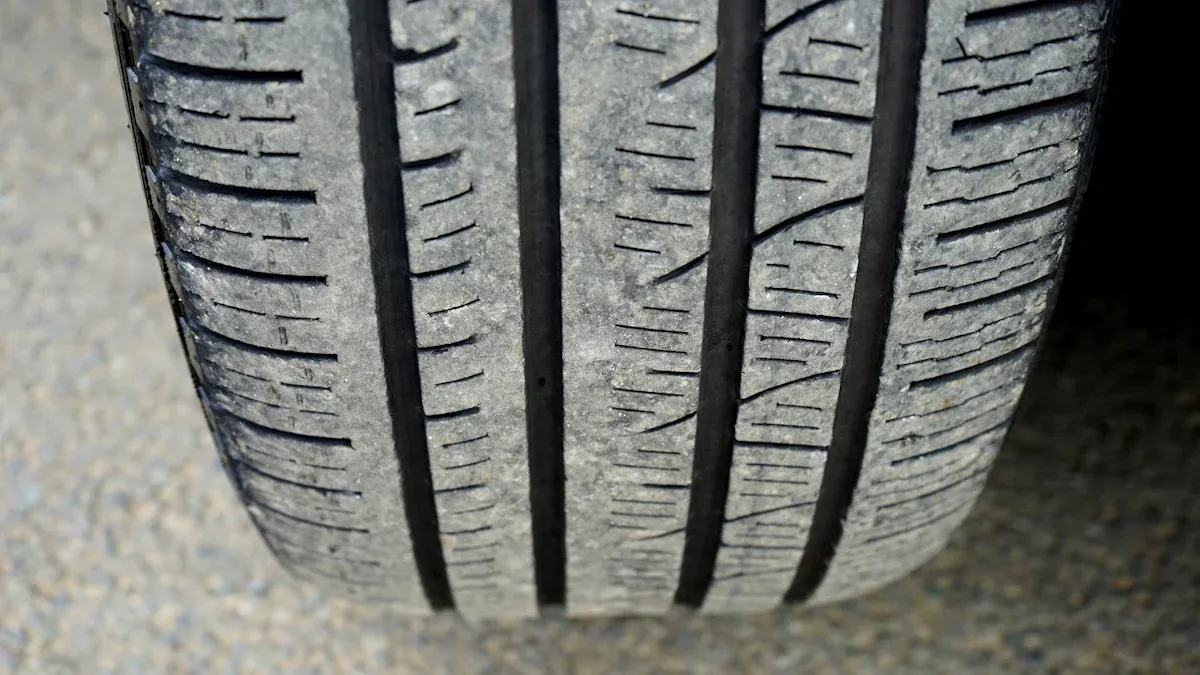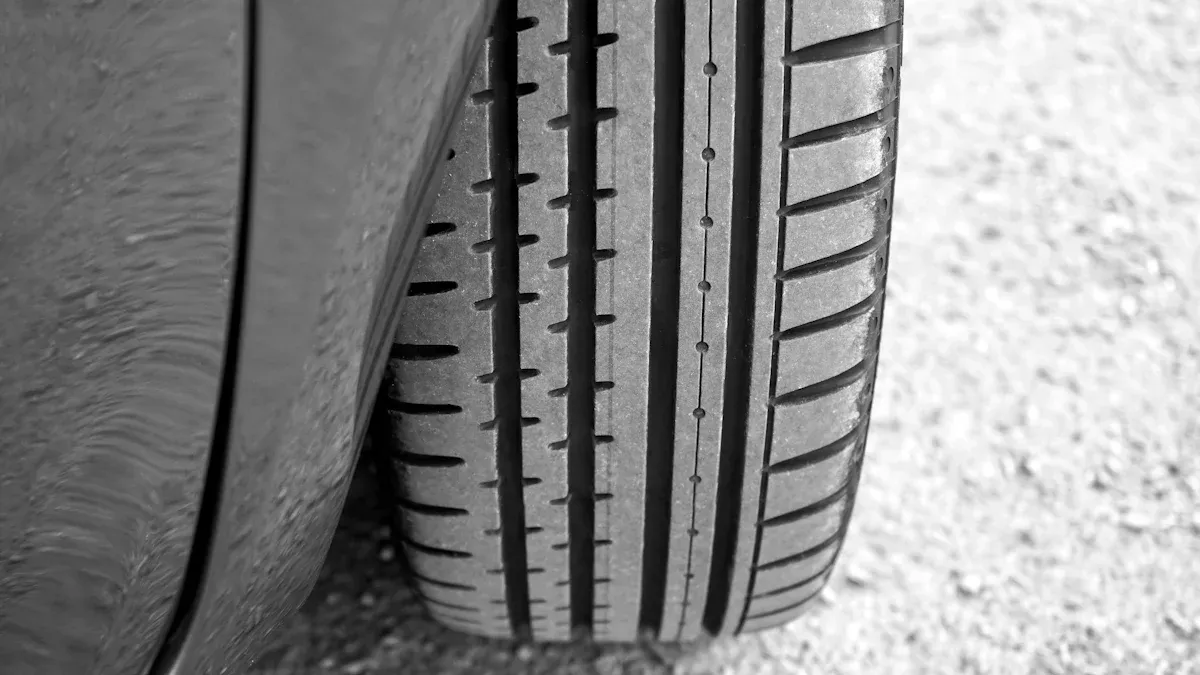
Measuring tire tread depth is very important for your safety. To measure tire wear effectively, you can use a merilnik globine profila, perform the penny test, or inspect the tires closely. Good tread depth helps your tires grip the road, especially when it’s wet outside, reducing the chance of hydroplaning. Knowing how to measure tire wear keeps you safe and helps your car perform better. Regularly checking your tires can significantly improve your driving experience!
Ključne ugotovitve
Keep your tire tread depth above 4/32 inches. This helps you stay safe and lowers the chance of hydroplaning on wet roads.
Uporabite merilnik globine profila or the penny test. Check your tires often, at least once a month and before long trips.
Change your tires when the tread depth hits 2/32 inches. This is the legal minimum to avoid fines and unsafe driving.
Look for uneven tire wear. Also, check tire pressure and alignment. This helps your tires last longer and work better.
Measuring and taking care of your tires makes your car handle better, stop faster, and keeps you safer overall.
Zakaj je globina profila pomembna

Varnostne posledice
Knowing about globino profila pnevmatike is very important for your safety. When your tires have enough tread depth, they can push water away from the road. This helps lower the chance of hydroplaning. Hydroplaning happens when water builds up between the tires and the road. This can make you lose control of your car. Studies show that tires with a tread depth of 6/32 inches or more lower hydroplaning risk by about 60%. But, as tread depth gets lower, this risk goes up a lot.
Here’s a quick look at how different tread depths affect hydroplaning risk:
Tire Tread Depth (inches) | Hydroplaning Risk Reduction (%) |
|---|---|
6/32 or more | 60 |
4/32 | 50 |
2/32 | 20 |
Manj kot 2/32 | 0 |
As you can see, keeping a tread depth above 4/32 inches is very important for safe driving, especially when it’s wet. Tires with tread depth below this level have trouble getting rid of water. This leads to a higher chance of losing grip.
Performance and Handling
Tire tread depth also matters for how well your vehicle performs and handles. When you drive on wet roads, the tread depth affects how long it takes to stop. For example, tires with a tread depth of 10/32 inches can stop in about 234 feet on wet roads. On the other hand, tires at the legal minimum of 2/32 inches need up to 52% more distance to stop. This shows a clear link between tread depth and stopping performance.
Here’s a table that shows the relationship between tread depth and wet stopping distance:
Tread Depth (32nds inch) | Wet Stopping Distance (feet) | Učinkovitost zaviranja (%) |
|---|---|---|
10/32″ (new) | 234 | 100 |
6/32″ | 253 | 92 |
4/32″ | 282 | 83 |
2/32″ (legal minimum) | 356 | 66 |
As you can see, as tread depth gets lower, the wet stopping distance gets longer. This means worn tires not only take longer to stop but also raise the chance of accidents, especially in heavy rain.
Also, tire tread depth affects how well your vehicle handles in different weather. Deeper treads give better grip, making cornering and stability safer. When tread depth gets low, your tires can’t grip the road well. This makes it harder to control your vehicle. Experts say to replace tires before the tread depth goes below about 4/32 inches to keep performance and safety at their best.
Legal Standards for Tread Depth
Minimum Tread Depth Standards
Knowing the legal rules for tire tread depth is very important for your safety. In the United States, the minimum legal tread depth for passenger cars is 2/32 inches (1.6 mm). This means that when your tires wear down to this level, they are not safe for driving anymore.
For commercial vehicles, the rules are stricter. Here’s a quick look at the minimum tread depth rules:
Vehicle Type | Tire Location | Minimum Tread Depth Requirement |
|---|---|---|
Passenger Vehicles | All tires | 2/32 palca |
Commercial Vehicles | Front (steering axle) tires | 4/32 palca |
Commercial Vehicles | Vse druge pnevmatike | 2/32 palca |
These rules make sure that commercial vehicles, which are heavier and need better handling, have enough tread depth for safety.
Consequences of Non-Compliance
Not following these minimum tread depth rules can lead to serious problems. First, driving on tires that don’t meet the legal standards can get you fines or penalties. Police can stop you and give you tickets if they see your tires are below the legal limit.
Also, worn tires greatly increase your chance of accidents. Tires with low tread depth have a hard time gripping the road, especially when it’s wet. This can cause longer stopping distances and a higher risk of hydroplaning.
Remember, keeping the right tire tread depth isn’t just about the law; it’s about keeping you and others safe on the road. Check your tires often and replace them before they reach the minimum tread depth to ensure the best performance and safety.
How to Measure Tire Tread Depth

Measuring globino profila pnevmatike is crucial for maintaining safety and performance. Here are three effective methods you can use to check your tire tread depth.
Uporaba merilnika globine profila pnevmatike
A tire tread depth gauge is a handy tool that provides accurate measurements. Here’s how to use it step by step:
Prepare the Gauge: Push the tread depth gauge against a flat surface and fully insert the measuring pin into the barrel to zero the gauge.
Insert the Pin: Place the measuring pin into the center of the main tread groove. Press down until the base of the gauge firmly contacts the tread on both sides.
Preberi meritev: Carefully remove the gauge by holding the barrel without touching the measuring pin. Read the tread depth displayed on the screen.
Repeat for Accuracy: Measure at least two more times, spacing the measurements about 15 inches apart. This helps account for any uneven wear.
Average Your Readings: Calculate the average of all readings to get an accurate tread depth.
Check All Tires: Don’t forget to measure all four tires, as wear may vary from one tire to another.
Timing Matters: Take measurements when the tires are cool and have not been driven on recently for the best results.
Using a tread depth gauge is one of the most reliable ways to measure tread depth. It provides quantitative results that help you assess your tires’ condition accurately.
Preizkus s pennyjem
The penny test is a quick and easy way to check your tire tread depth without any special tools. Here’s how to do it:
Vstavite penny: Take a penny and insert it into the tire tread with Lincoln’s head facing down.
Preverite vidljivost: If you can see the entire head of Lincoln, your tread depth is less than 2/32 palca, which means it’s time to replace your tires.
While the penny test is simple, it has its limitations. It only indicates when your tread depth has reached the legal minimum of 2/32 inch. This means your tires are already unsafe when the test suggests wear. For better safety, consider using the quarter test instead, which checks for a safer tread depth of 4/32 palca.
Visual Inspection Techniques
Visual inspections can also help you assess your tire tread depth. Here are some key indicators to look for:
Tread Wear Indicators: Most tires have wear bars molded into the tread grooves. When these bars become flush with the tire tread, it signals that the tread depth has reached the legal minimum of 2/32 inch. This is a clear sign that you need to replace your tires.
Uneven Wear Patterns: Look for any signs of uneven wear, which can indicate alignment issues or other problems. If you notice significant differences in tread depth across the tire, it’s time to consult a professional.
General Condition: Check for cracks, bulges, or other visible damage. These can compromise your tire’s integrity and safety.
While visual inspections are helpful, they can be subjective and depend on your ability to spot issues. For the most accurate results, combine visual checks with a tread depth gauge.
By regularly checking your tire tread depth using these methods, you can ensure your tires remain safe and effective on the road. Remember, maintaining proper tread depth not only enhances your vehicle’s performance but also keeps you and others safe.
Tips to Measure Tire Wear
Regular Checks
To keep your tires in great shape, measure tire wear often. Here are some tips to help you remember:
Check Monthly: Look at your globino profila pnevmatike at least once a month. This helps you find problems early.
Pred daljšimi potovanji: Always check your tires before long trips. You want to make sure they’re safe for driving.
Frequent Checks for High Mileage: If you drive a lot or on rough roads, check your tread depth more often. This helps you avoid surprises.
Professional Inspections: Think about getting a professional inspection during regular maintenance. Experts can give you a detailed look at your tire health.
Following these steps can help you keep the right tread depth and improve your safety on the road.
Monitoring for Uneven Wear
Watching your tires for uneven wear is just as important. Here’s how to do it:
Watch for Tread Wear Indicators: Most tires have built-in indicators. When these are level with the tread, it’s time to get new tires.
Check Tire Pressure: Regularly check your tire pressure. Low pressure can wear the edges, while high pressure can wear the center.
Look for Alignment Issues: If you see uneven wear patterns, it might be from wheel misalignment. Get your alignment checked if you notice slanted or feathered wear.
Inspect Suspension Components: Worn shocks can cause uneven wear. Regularly check your suspension to make sure it’s working well.
Adopt Gentle Driving Habits: Avoid fast driving. Smooth starts and stops can help reduce tire wear.
By watching for uneven wear, you can make your tires last longer and avoid replacing them too soon. Remember, a little care goes a long way in keeping your tires healthy!
Checking your tire tread depth often is very important for your safety and how well your car works. Keep these important points in mind:
Keep a tread depth of at least 4/32 palcev for safety.
Uporabite orodja, kot so tread depth gauges or the penny test to measure correctly.
Watch for uneven wear to find problems early.
Doing these things helps you follow the law and makes driving better. So, take care of your tires—your safety relies on it! 🚗💨
Pogosta vprašanja
Kako pogosto naj preverjam globino tekalne plasti pnevmatike?
You should check your tire tread depth at least once a month. Also, inspect them before long trips to ensure safety and performance.
What is the best method to measure tread depth?
Using a merilnik globine profila is the most accurate method. The penny test is a quick alternative, but it only indicates when tread depth is at the legal minimum.
What happens if my tread depth is too low?
Low tread depth can lead to poor traction, longer stopping distances, and increased risk of hydroplaning. It’s crucial to replace tires before they reach 2/32 inches.
Can I visually inspect my tires for tread wear?
Yes! Look for wear indicators and uneven patterns. If the wear bars are flush with the tread, it’s time to replace your tires.
Why is tread depth important for performance?
Tread depth affects your vehicle’s grip on the road, especially in wet conditions. Deeper treads provide better handling and shorter stopping distances, enhancing overall safety.
Glej tudi
Step-By-Step Guide To Measuring Tire Tread Depth Accurately
Pomen rednih pregledov globine profila pnevmatik za varnost
Razumevanje delovanja pametnih senzorjev globine profila pnevmatik






